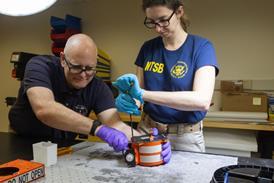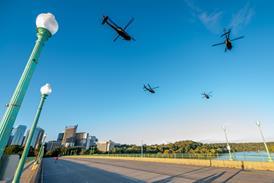Julian Moxon/PARIS
At first sight, it might be difficult to appreciate the significance of the all-composite fuselage shell sitting on makeshift landing gear at Eurocopter France's Marseilles factory. It is, however, the visible evidence of progress on what is potentially the largest helicopter programme ever undertaken in Europe. The four participating nations (France, Germany, Italy and the Netherlands) are due to procure 726 machines. If hoped-for exports materialise, the production run could easily exceed 1,000 helicopters.
The first fuselage will become a complete aircraft later this year, with a first flight planned for December. Preliminary contacts with potential export customers are already under way, with the long-term hope that the UK, once an NH90 partner, may be enticed to rejoin the programme at the production stage. Other European countries are also being contacted now that the approximate export price of the basic helicopter has been settled. "We are aiming for the NH90 to cost no more than its competitors in the market today," says Eurocopter president Jean Francoise Bigay, who estimates the price of a non-missionised NH90 to settle at "around $15 million".
The definition of what constitutes a "basic" NH90 remains open and says NH Industries Marketing Chief Alain Gauthier, will "depend on what individual customers want. We're adopting the same philosophy as with the Cougar...defining the basic system, then offering the add-on options."
NH90 work-share is split in approximately the same proportions as that of procurement, with France taking 42.4%, Germany 24%, Italy 26.9% and the Netherlands 6.7%. The centre and rear fuselages, produced by Eurocopter Germany, and the forward structure, from Eurocopter France, were assembled in December 1994. Arrival of the tail unit from Fokker, meant that the first fuselage could be completed at Eurocopter's Marignanne plant, near Marseilles, France. The structure modules for the Iron Bird (upper deck, rear and tail structures) have also arrived at Agusta's plant at Cosina Costa, Italy.
There will be five NH90 prototypes: after the first flight of the basic aircraft in December, the second and third examples, also in basic configuration, will take to the air in 1996. The fourth prototype, configured as the tactical-transport helicopter (TTH) army version, will actually fly after the fifth, at the end of 1997. The fifth aircraft, in NATO frigate helicopter (NFH) guise, will be ready at the beginning of the same year. Of the 726 aircraft so far planned, 544 will be TTHs, and 182 NFHs.
PROGRAMME MANAGEMENT
The programme is being managed by NAHEMA (NATO helicopter management agency), which awarded NH Industries (NHI) the ECU 1.376 billion ($1.1 billion) fixed-price design and development contract in September 1992. NHI will also be responsible for industrialisation, production and logistics for the helicopter, as well as marketing and sales. "We think the production investment will amount to about ECU600 million," says Gauthier, "although that is not finalised yet. It depends on things like the number of production lines there are and whether any new countries have joined the programme."
The NH90 contract calls for the award of tooling contracts to begin on 1 January, 1996, while production was contractually set to begin a year later, with delivery on the first day of the year 2000. Both of these dates are known to have slipped by approximately one year. "The crunch will come with the industrialisation decision," says one source close to the programme, "which is when the four partners have to come up with money for the production stage."
The awards of NH90 work packages are divided into those, for the basic aircraft and those for the missionised terrestrial and naval versions. Almost all have been advertised globally (apart from the landing-gear contract, which was considered part of the German non-awardable airframe component, but was subsequently awarded to component-maker Liebherr.
Each partner has responsibility, for issuing requests for proposals, for specific packages and choosing the supplier, although, that choice must be ratified by, the three other partners. This has worked well so far, says Torres, and about a quarter of the basic packages have been awarded so far. The only problem to date was in the selection of engine supplier. Eurocopter France chose the Rolls-Royce/Turbomeca RTM.322, while Italy insisted on the General Electric T700 (in which Fiat has a significant manufacturing stake). The solution was to make the RTM-322 the basic engine, allowing Italy and any other customers to choose the T700.
The remaining work packages for the basic helicopter should be cleared "within a few weeks" , says Torres. These include (under the responsibility of Eurocopter France) the navigation and environmental-control systems, and multi-function displays (the NH90 will have five 200 x 200mm displays), the control display units (Eurocopter Deutschland), and the Plant Management Computer (Agusta).
A choice on who will supply, the flight-control computers for the NH90's fly-by-wire flight control system is about to be made. Contenders include Alenia/Sfim, Sextant/ Agusta Systemi, Alenia on its own and Lear Astronics. Liebherr has already been chosen to supply the actuators, these components having been taken away from the overall FCS package.
The awards of mission-systems contracts will take place throughout 1995, using exactly the same method as for the basic helicopter packages. "We establish a list of potential companies," says Torres, "then select on the basis of technology and price competitiveness." The competitions for the major mission-equipment packages will be especially hard-fought, since in both tactical and naval roles, the NH90 will carry complex (and high-value) systems.
The naval version, for example, will have to carry out autonomous detection, classification, tracking and attack of targets in its anti-submarine warfare role, as well as having an over-the-horizon targeting capability. Both variants will feature electronic-warfare systems, and numerous mission flight aids.
SHY OF THE PUBLIC EYE
A mock-up of the engine, transmission and rotor installation has been assembled at Marignanne, revealing the NH90's unique inter-blade lead-lag damper system, which Torres says is "...designed to save weight and add simplicity". Windtunnel testing of the Spheriflex blade/titanium hub rotor configuration is under way at wind tunnels in Germany and the Netherlands, while main and tail-rotor transmission development continues at Agusta.
At Eurocopter Deutschland's development centre at Ottobrun, near Munich, the second main NH90 fuselage centre and rear sections are already completed, and recent trials have been carried out on the installation of naval equipment for the NFH version. The NH90 has remained shy of the public eye, but the impression is gained that a great deal of work has been going on behind the scenes.
While the first NH90 is taking shape, the Tiger anti-tank helicopter and the civil EC-135, are well into their flight-test programmes, while assembly of the EC-120 is due to begin shortly. This has resulted in more development work at Eurocopter's French and German centres than has been seen in 25 years.
Although it is easy to be sceptical that a programme as big as the NH90 will see the light of day, recent positive support from the French ministry of defence has given morale a badly needed boost. Whether the four countries stay committed to the programme remains to be seen, and no doubt there will be continued rumblings about the Eurocopter Cougar and Sikorsky UH-60 Black Hawk being less expensive options.
There is, however, no doubt that the NH90, with its more recent airframe technology, and advanced mission equipment, will provide significantly more capability than today's machines.
"The NH90," says Gauthier, "will be the only all-new 9t transport helicopter on the market when it becomes available. We think it stands a very good chance of becoming the standard replacement for all helicopters in that class."
Source: Flight International























